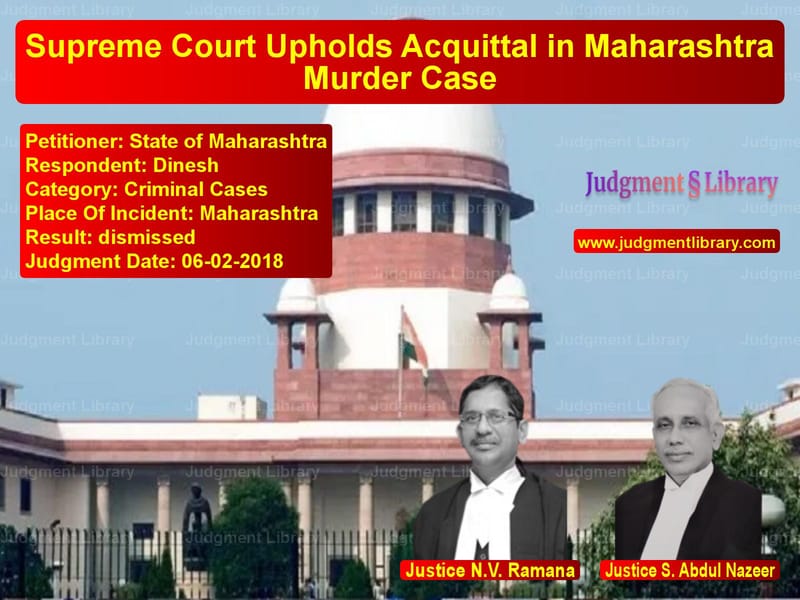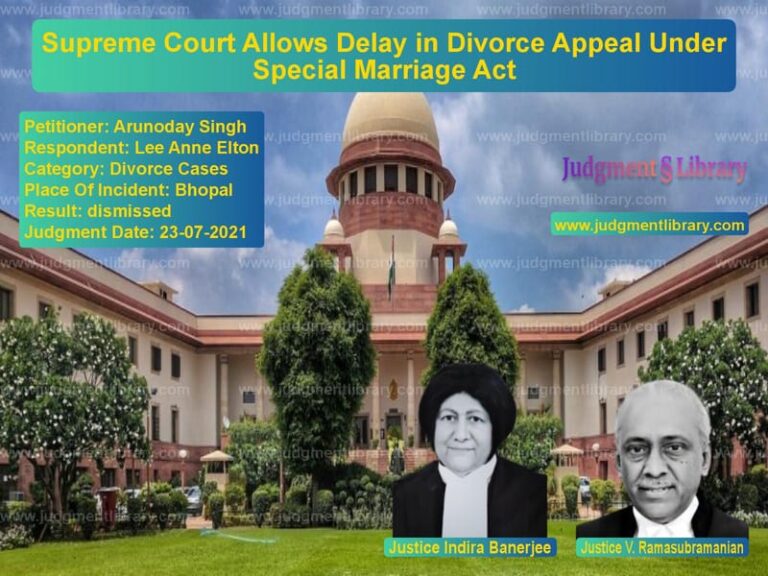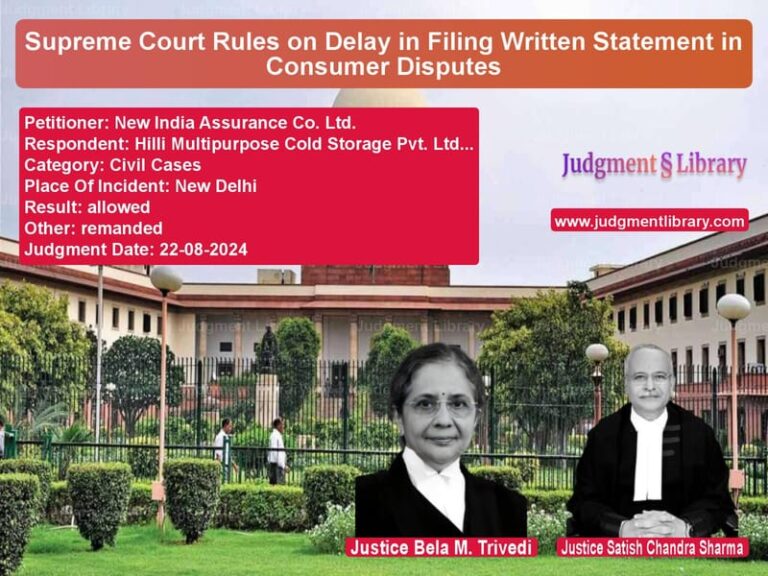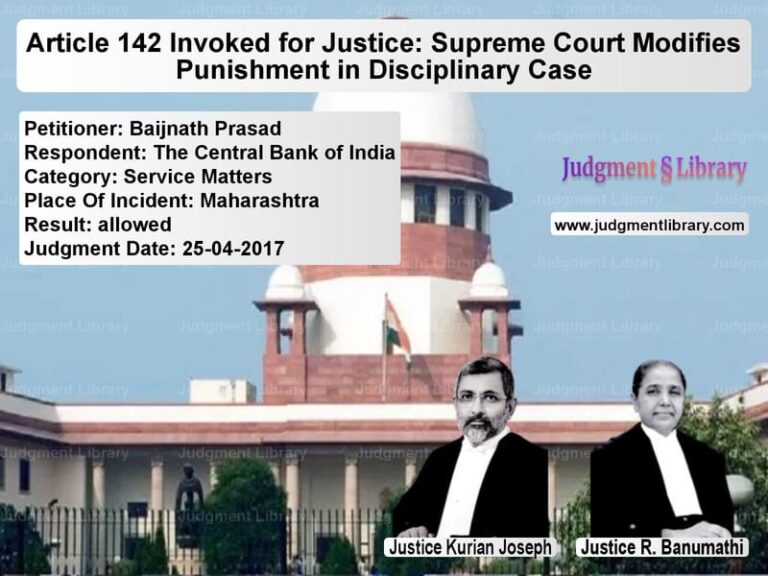Supreme Court Upholds Acquittal in Maharashtra Murder Case
The case of State of Maharashtra vs. Dinesh is a significant ruling by the Supreme Court of India concerning a murder case in which the prosecution failed to prove its case beyond a reasonable doubt. In its judgment dated February 7, 2018, the Supreme Court upheld the Bombay High Court’s decision to acquit the accused, reinforcing the principle that conviction cannot be based on unreliable eyewitness testimony.
This judgment underscores the importance of stringent scrutiny in criminal cases, particularly when the prosecution’s case relies on a sole eyewitness.
Background of the Case
The case involves the prosecution of two accused for the murder of Rakesh Dattaji Chavan. The primary allegations were:
- Accused No. 1, Ajay, was charged with committing the murder.
- Accused No. 2, Dinesh (the respondent in the appeal), was charged under Section 201 read with Section 34 of the Indian Penal Code (IPC) for allegedly destroying evidence by cutting the victim’s corpse into pieces and disposing of it.
The trial court convicted Dinesh and sentenced him to three years of rigorous imprisonment with a fine of Rs. 500. However, the High Court acquitted him, prompting the State of Maharashtra to appeal before the Supreme Court.
Key Legal Issues
- Whether the High Court erred in acquitting Dinesh despite the prosecution’s evidence.
- Whether the testimony of the sole eyewitness (PW7 – Pushpabai) was reliable and sufficient for conviction.
- Whether the lack of corroborative evidence weakened the prosecution’s case.
Petitioner’s Arguments (State of Maharashtra)
The State argued:
“The High Court has erred in acquitting the accused despite clear evidence from the sole eyewitness, PW7 – Pushpabai, who saw the accused cutting the victim’s body into pieces.”
The prosecution contended that:
- PW7 was an eyewitness who directly saw the accused engaged in the crime.
- The trial court had rightly convicted the accused based on PW7’s testimony.
- The High Court overlooked material evidence while granting acquittal.
Respondent’s Arguments (Dinesh)
The defense countered:
“The testimony of PW7 is unreliable as she did not immediately report the incident and her account contains inconsistencies.”
The respondent pointed out:
- PW7 claimed to have witnessed the crime at night, but the location had no electricity, making it difficult to identify the accused.
- Despite witnessing a gruesome crime, neither PW7 nor her husband raised an alarm.
- PW7’s statement was recorded one and a half months after the incident, raising doubts about its credibility.
- The prosecution failed to conduct a test identification parade.
- There was no forensic evidence linking the accused to the crime scene.
Supreme Court’s Decision
The Supreme Court ruled:
“When the entire case hinges on the evidence of a sole witness, a paramount duty is cast on the Court to carefully scrutinize such evidence and find out whether such evidence is worth credence or not.”
The Court cited previous judgments emphasizing the necessity of caution in cases relying on a sole eyewitness:
- In Joseph v. State of Kerala (2003) 1 SCC 465, the Court held that sole eyewitness testimony must be tested against other material evidence.
- In State of Haryana v. Inder Singh (2002) 9 SCC 537, the Court ruled that sole eyewitness testimony must be confidence-inspiring.
- In Ramnaresh v. State of Chhattisgarh (2012) 4 SCC 257, it was reaffirmed that sole eyewitness testimony must be corroborated.
Applying these principles, the Supreme Court found several issues with the prosecution’s case:
- PW7 did not identify Dinesh immediately.
- Her husband, allegedly another eyewitness, was never examined in court.
- There was no test identification parade.
- The prosecution failed to establish a forensic link between the accused and the crime.
Considering these weaknesses, the Supreme Court upheld the High Court’s decision and dismissed the State’s appeal, affirming Dinesh’s acquittal.
Implications of the Judgment
The Supreme Court’s ruling has far-reaching implications:
- Ensures Due Process: The judgment reinforces the principle that an accused cannot be convicted solely on weak or uncorroborated evidence.
- Emphasizes Fair Trial: The ruling underscores the need for robust prosecution evidence in cases relying on sole eyewitness testimony.
- Guidelines for Future Cases: The judgment sets a precedent on evaluating the credibility of sole eyewitnesses.
Conclusion
The Supreme Court’s ruling in State of Maharashtra vs. Dinesh reinforces the judiciary’s commitment to fair trials. By upholding the acquittal, the Court emphasized that criminal convictions must be based on reliable, corroborated evidence. The case serves as a precedent for similar cases, ensuring that justice is not compromised due to procedural or evidentiary lapses.
Petitioner Name: State of MaharashtraRespondent Name: DineshJudgment By: Justice N.V. Ramana, Justice S. Abdul NazeerJudgment Date: 06-02-2018
Don’t miss out on the full details! Download the complete judgment in PDF format below and gain valuable insights instantly!
Download Judgment: State of Maharashtra vs Dinesh Supreme Court of India Judgment Dated 06-02-2018.pdf
Direct Downlaod Judgment: Direct downlaod this Judgment
See all petitions in Murder Cases
See all petitions in Bail and Anticipatory Bail
See all petitions in Fraud and Forgery
See all petitions in Judgment by N.V. Ramana
See all petitions in Judgment by S. Abdul Nazeer
See all petitions in dismissed
See all petitions in supreme court of India judgments February 2018
See all petitions in 2018 judgments
See all posts in Criminal Cases Category
See all allowed petitions in Criminal Cases Category
See all Dismissed petitions in Criminal Cases Category
See all partially allowed petitions in Criminal Cases Category







